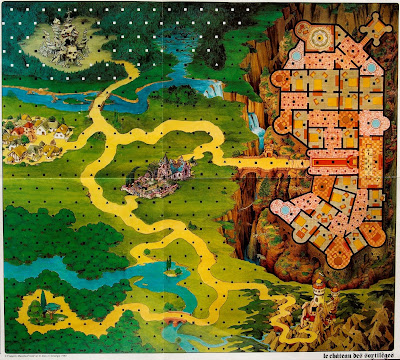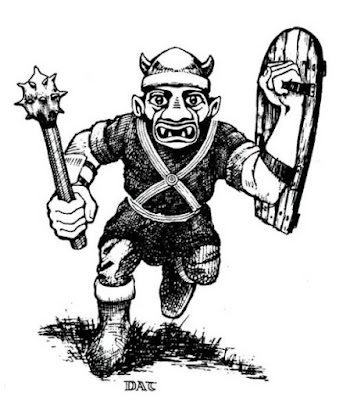The influence of Dungeons & Dragons on Le Château des Sortilèges is very clear, particularly when you look at its counters.
The depictions of the zombie, ghoul, troll, and goblin all look remarkably like those in the AD&D Monster Manual. For comparison, here's Dave Trampier's goblin from the MM:
The second collection of counters also includes illustrations that are obviously derivative of those in the Monster Manual. Pay close attention to the demon, for example, which appears to have been cribbed from Sutherland's Asmodeus. Several of the other counters show resemblances to artwork by both Trampier and Dave Sutherland.
I'd never heard of Le Château des Sortilèges before and am grateful to reader Adamo Dagradi for sharing these images with me. The late 1970s and early 1980s were a fascinating time, as many of the foundational concepts we now associate with fantasy were in the process of being formed. I imagine this process was especially fascinating in countries outside the English-speaking world about which I know comparatively little. Le Château des Sortilèges is a good example of what was happening in France during this period. I have no doubt there are many more fantasy games like this one that offer insight into the early development of the genre.





The fact that the player characters seem to be fighter, magic user, cleric and thief also adds to it.
ReplyDeleteAbsolutely.
DeleteLooks super cool! Does your friend have any insights to share about how game play works?
ReplyDeleteThere's some useful information here: https://boardgamegeek.com/boardgame/14848/le-chateau-des-sortileges
DeleteWell, I can give a quick rundown of the rules as best I remember them, since I played (either solo or with friends and family) the heck out of this game in the early 80's.
DeleteEach PC is define by class (so yes, fighter, magic-user, cleric and thief), a number of hit points (fighters have 2d6+2 and magic-users 1d3+1, that is apparently etched forever in my memory), AC and move rate (which is always 2 and is also indicated in the bottom left corner of the chit). The "AC" is the number in the bottom right corner of the counter and is the minimum the opponent need to roll on a d6 to hit (so 5+ to hit the fighter). Damage inflicted is by the weapon (1d6 for sword, 1d3 for dagger).
As for the monsters, the number in the upper left corner is the number of hp and upper right is damage.
Magic-users need to roll to successfully cast their spells (sleep and fireball, if I remember correctly). Clerics heal and also need to roll to succeed. Only thieves can detect/remove traps and pick locks.
And then everything else is randomly generated.
Depending on where your party goes, you roll a die to see how many monsters and treasure chips you blindly pick and then you fight (or run). Again from memory, round dots on the map are safe; on triangle ones, you have maybe a 50% chance of encountering weak monsters and the square ones are the really dangerous ones where you could meet the "special" monsters (they have a star on their counters) and find the real treasures (magic stuff and gems).
Every room in the castle (that occupies the right hand part of the map) is potentially locked and trapped. And the secret room in the northern part of the castle (the door is the wavy line) always has tough creatures and the best treasures; and, of course, only the thief has a (weak) chance of opening it. So you would try turn after turn to roll that 6 to open the door while also rolling for a monster encounter every turn and usually get wiped out by a nasty roll or just give up.
There are random tables to roll on for the different types of traps and what happens when you from the fountains that dot the castle map. In fact, lots of random tables.
It's GM-less and only uses d6s. It was also remorselessly lethal and even meeting "weak" monsters could quickly turn into a TPK.
There is no provision for level advancement (but I quickly remedied to that and greatly expended the various random tables).
So I guess it is influenced by Dungeon! (but I never played it so can't say for sure) and probably Chainmail.
Looking back and knowing what I know now about OD&D, I think it perfectly emulate that old-school feeling of mystery and danger.
IMHO, that map is absolutely beautiful and I can still connect with my 12 year old self who spent countless hours looking at it and imagine stories and possible encounters based on it.
It was my first "rpg" experience, and it is still to me the really seminal, perfectly basic ruleset that just needs a few house rules (reaction rolls and morale rules from B/X mostly) and that I keep coming back to whenever I want to introduce children (even adults sometimes) to roleplaying.
Wow! Fantastic write-up. Thank you for that. Were you in Europe as a child, or did you find this game in the States?
DeleteJames, for Italy you should have a look at the quasi-rpgs designed by Marco Donadoni for International Team in the early '80s.
ReplyDeleteIn particular Magikon (fantasy) and Septima Legio (space exploration). I bet you'd love Septima Legio.
Some of these games were also translated in English by International Team.
Very interesting. I wonder what's up with the loup-garou illustration; it doesn't look much like a werewolf. BTW, the MM Asmodeus is by Sutherland, not Trampier (who did all the other MM pictures of devils). Tit for tat, Trampier drew Juiblex while Sutherland did all the other demons.
ReplyDeleteThanks for the correction! I thought it might be him, but all the other devils were DAT, so I assumed Asmodeus was his too.
DeleteThe loup-garou looks very much like Henry Hull in the 1935 film 'Werewolf of London.' It was the first Hollywood movie to feature a werewolf.
DeleteAs I wrote to James I managed to play it a couple of times using homemade printed counters and having the map laminated in A3 format. All resources easily downloadable online, including the english rules. You pick up your four men group: wizard (only the sleep spell), cleric (only heal), warrior (more hit points) and thief (can disarm traps). You roll hit points and assign weapons (with usual d&desque restrictions). Then you travel on the map, pulling chits from the bowl. Chits can be monsters or treasure. Monsters have special abilities and marching order is quite important for attack purposes. Monsters have a hard time hitting the warrior but go easy peasy on magician. Hexes with a triangle are safer than hexes with a square (but less chance of treasure). Inside the castle every room has a chance to be trapped, so thief takes point. There also special treasures and healing pools proprietary to the structure. You can split the group and pay the consequences but can make sense as two grouos can play at the same time and challenge for treasure. All in all a nice piece of vintage from another era, that with some house rules cam be easily expanded. No level up at the end: you go back to the village or die pushing your luck too far. My biggest disappointment is that the map has some beautiful landmarks but it makes little sense to visit them as everybody would want to run to castle (which could be dangerous with basic weapons and potions). You can find magic armour, rings, swords, daggers and maces. That's it basically. I tried to find an original copy of the magazine but it's like hunting white buffalo without being Charles Bronson. Sorry for the obscure movie reference.
ReplyDeleteMarcela-Froideval is also a comic book author, he wrote the fantasy series Black Moon Chronicles. A big hit in France and other parts of Europe
ReplyDeleteAwesome...that map's a beaut!
ReplyDeleteFascinating bit of gaming history there.
ReplyDeleteAlso, "orque" just plain looks classier than orc, much less GW's "ork" spelling.
Hahaha! I agree, and I love all of your comments Dick.
DeleteBy contrast, the French band Magma has a great track called “Ork Alarm” on their 1974 album, “Köhntarkösz”. (And, yes, the umlauts are there just for looks.)
ReplyDeleteI went looking for a bigger map image and found the french blog that talks about the game. https://anniceris.blogspot.com/2011/12/jdrosr-le-chateau-des-sortileges.html. Reading french is easier than listening to it.
ReplyDeleteThe depiction of the orc and balrog are from SPI's War of the Ring.
ReplyDelete"Le château des sortilèges" itself heavily inspired a BASIC program published in "L'Ordinateur Individuel Hors-série n°54" in 1983. You can tell because it has the exact same monsters with the exact same stats, and they are listed in the same order.